大学英语三级阅读理解PPT课件
大学英语三ppt课件

Foster critical thinking by engaging students in comparative analysis of cultural and linguistic differences between the source language and their native language, enhancing their intercultural awareness
01
Course Introduction and Learning
Chapter
Introduction to the Three Courses
01
Comprehensive English Course
A course that covers all aspects of English language skills,
A wide range of topics and levels of diversity in listening materials can help students develop their listening skills in different contexts and gradually increase their listening efficiency
English Course"
03
Reference Materials: Oxford English Dictionary,
grammar and writing handbooks
Textbooks and Reference Materials
Business English Course Textbook: "Business English: A Complete Course" Reference Materials: Business dictionaries, trade publications, and financial reports
新标准大学英语综合教程3-unit1-Active-Reading-1-PPT优秀课件

Mapping Embarkation Navigation Destination Resources
Active reading 1: Mapping
Getting tips on how to get to know oneself
Learning to use narrative devices
More
10
Active reading 1: Embarkation
If
If you can talk with crowds and keep your virtue, Or walk with Kings – nor lose the common touch, If neither foes nor loving friends can hurt you; If all men count with you, but none too much, If you can fill the unforgiving minute With sixty seconds’ worth of distance run, Yours is the Earth and everything that’s in it, And – which is more – you’ll be a Man, my son!
7 More
Active reading 1: Embarkation
Graduation
Will we think about tomorrow like we think about now? Can we s_u__rv_i_v_e__it_o__u_t there? Can we _m__a__k_e__it somehow? I guess I thought that this would never end And suddenly it’s like we’re women and men Will the past be a __s_h_a_d_o__w__ that will follow us round? Will these memories __fa_d__e____ when I leave this town I keep, I keep thinking that it’s not goodbye Keep on thinking it’s a time to fly As we go on, we remember All the times we had together And as our lives change, come whatever We will still be, friends forever
大学英语三级考试教程ppt课件

文章连贯(Text Coherence)
♫Helicopters flying overhead made me uneasy. I had to constantly remind myself that these were most often civilian and not military helicopters. I had to remind myself that the ambulances were not rushing to evacuate wounded demonstrators.
anything about the subject? If so, what?
文章连贯(Text Coherence)
♫ 连贯意味段落中句子意思地连贯表 达。段落中句子或者在逻辑,或者 在语法上是彼此联系的。通常,一 个段落中所有的句子都应给予同样 的关注。
文章连贯(Text Coherence)
确认暗含意(indentifying the
implied idea)
♫ For example: direct marketing today occurs either in the form of a direct response, which requires a salesperson to complete the sale, or by direct order, which is a sale made without a personal saleis the selling of products without a shop, as with Avon. Com or Amway. Comproducts. Telemarketing, catalog shopping, personalized mailings, and trial offers are all ways to conduct direct marketing.
国A英语3级PPT课件
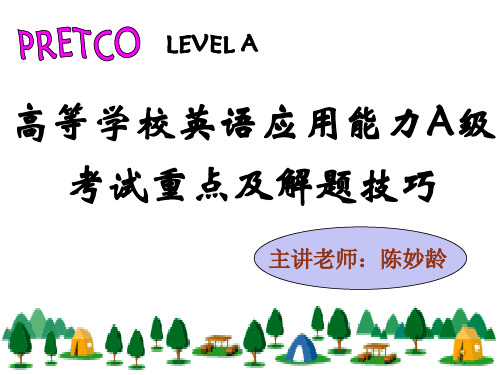
Section A 理解简单会话(MC)
Section B 理解较长会话(MC) Section C 理解短文--简答题 2. 语法结构(15%,20小题,时间15分钟) Section A 选择(MC) Section B 填充(包括词形变 化)
3. 阅读理解(35%,25小题,时间40分钟) Task 1 阅读一般篇章(MC) Task 2 阅读应用文(MC) Task 3 阅读应用文(填表) Task 4 阅读目录/表单(匹配) Task 5 阅读应用文(简答题)
A) take
B) takes
C) took
D) will take
② The representative of the company demanded that part of the agreement ________ revised. (2006.6) A) will be B) is C) to be D) be
2. 谓语动词的时态与语态
Since…, …have done/have been doing
e.g. Ever since I arrived here, I ________ in the dormitory because it is cheaper. (2006.6) A) Lived C) had been living B) was living D) have been living
③ He might have been killed in that car accident had taken yesterday if he (take) __________ part in that
activity with the team. (2005.12)
大学英语三课件

CF: haul, drag & pull 这几个都是动词,都有
“拖”、“拉”、“拽”之意。 。 haul 指缓慢而费力地拖一极重之物,有时可表示 很困难地拽。例如: Lorries haul heavy goods from factories to the ports. 大卡车把沉重的货物从工厂运到港口。 drag 指施力者在地面或表面 地面或表面上缓慢而沉重地把东 地面或表面 西拖过一段距离,该词通常使人想到主动或被动的 阻力。例如: You might drag a heavy box across the ground if you couldn’t lift it. 提不动一个重箱子,你可以在地上拖着它走。
4
虽然那天清晨落叶满地, 虽然那天清晨落叶满地, 两条路都未经脚印污染。 两条路都未经脚印污染。 留下一条路等改日再见! 呵,留下一条路等改日再见! 但我知道路径延绵无尽头, 但我知道路径延绵无尽头, 恐怕我难以再回返。 恐怕我难以再回返。
5
也许多少年后在某个地方, 也许多少年后在某个地方, 我将轻声叹息把往事回顾, 我将轻声叹息把往事回顾, 一片树林里分出两条路, 一片树林里分出两条路, 而我选了人迹更少的一条, 而我选了人迹更少的一条, 从此决定了我一生的道路。 从此决定了我一生的道路。
17
8. (L22) spray: vt. force out liquid in small drops upon (followed by with)喷洒 I’ll have to spray the roses with insecticide to get rid of the greenfly (蛀 虫). They sprayed the President’s car with bullets. 汽车开过,溅了我一身水。 A car went past and sprayed me with water.
大学英语3PPT课件

教师:冯娇娇
.
1
Unit 3-Text B
Text B: Is a Stress-free Life Possible?
Is Stress-free Life Possible?
.
PPT模板下载:/moban/ 节日PPT模板:/jieri/ PPT背景图片:/beijing/ 优秀PPT下载:/xiazai/ Word教程: /word/ 资料下载:/ziliao/ 范文下载:/fanwen/ 教案下载:/jiaoan/ 字体下载:/ziti/
I sit around all day and eat junk food out of boredom. 因为无聊,我一整天坐着吃垃圾食品。
She could no longer stand the boredom of having nothing to do. 她再也无法忍受无事可做的无聊状态了。
.
3
Stress-free
—无压力的; Smoke-free
—无烟的;禁止吸烟的; Alcohol-free
—不含酒精的; Fat-free
—无脂肪的;脱脂的;
.
4
live out
— to continue to live in a particular way or place until you die Examples:
.
8
Assisted living home
The assisted living home is designed to provide residents with assistance with basic activities of daily living such as bathing, grooming, dressing, and more. Residents have as much independence as they want with the knowledge that personal care and support services are available if they need them. Some states also allow assisted living to offer medication assistance and/or reminders. Assisted living communities differ from nursing homes in that they don’t offer complex medical services.
大学英语阅读三级passage1-10

(Passage 1The secret of being born lucky is a summer birthday, with May babies most likely to enjoy a lifetime’s good fortune, according to a study of more than 40,000 people. The time of year at which you are born has an enduring influence on levels of optimism and self-reported luck, according to research by British and Swedish scientists. May was the luckiest month in which to be born, with 50 per cent of those born then considering themselves lucky, while October was the least lucky month, with just 43 percent claiming good fortune.The findings add to growing evidence that the phenomenon of luck is not all down to chance, but is affected by a person’ s general disposition.Other research has shown that whether people think themselves fortunate depends less on objective success than on having a “glass half-full” or “half-empty” approach to life. “What we are seeing suggests that something is influencing how people perceive their luckiness. My hypothesis is that people create their own luck by traits such as optimism, that luck is a psychological phenomenon rather than a matter of blind chance,” said Professor Richard Wise man, who led the research.The pattern of the results, with those born in spring and summer reporting themselves luckier than those born in autumn or winter, could have two potential explanations, Professor Wiseman said.1. According to the passage, whether people think themselves lucky not depends on the following factors EXCEPT ______A) one’s objective success B) one’s general di sposition·C) one’s attitude to life D) one’s place of birth2. According to the passage, those who were born in _______ regard themselves as the most fortunate.A) March B) April C) May D) October3. Which of the following statements is TRUE according to the passageA) Optimistic people tend to be luckier.B) Devoted people tend to be luckier.!C) Objective success is more important than one’s general disposition in feeling lucky.D) People drinking more water tend to be luckier.4. Which of the following words can best replace the word “trait”(Line 8, Para. 2)A) quality. B) expectation. C) belief. D) idea.is the best title for the passageA) Luck is Something Born.@B) Luck is Not All Down to Chance.C) Luck is A Matter of Blind Chance.D) Luck and Age.Passage 2Researchers say most of us make instant judgement about a person on the basis of how they look. They say facial features can determine whether we like or trust someone. It may even influence how we vote.“Over the years, we have found that facial features affect the way many of us perceive others,” says Elisabeth Cornwell, a psychology researcher at the university’s Perception Laboratory. Studies suggest that people are less likely to trust those with particularly masculine features, such as a square jaw, small eyes or big nose. “They are perceived as dominant and less trustworthy,” says Ms Cornwell. “It doesn’t mean that men who look more masculine are less trustworthy—It’s just our first impressions. “ T hose with less masculine features—larger eyes, a smaller nose and thinner lips—are deemed to be more trustworthy. “We are very good at processing these features quickly,” says Ms Cornwell.`The researchers are putting their science to the test at the Roya l society’s annual summer exhibition in London. They have subtly manipulated the faces of Prime Minister Tony Blair, Conservative leader Michael Howard and Liberal Democrat leader Charles Kennedy accentuating their dominant and trustworthy features respectively. “We have used a computer programme to change the shape of their face and features. We hope it will help people to understand our work.” So should we expect to see Tony Blair, Michael Howard and Charles Kennedy at the exhibition getting tips “I don’t think it’s something they will want to try,” says Ms Cornwell. “It’s not really possible with television. We all know what they look like. I think they would be naive to try it.”1. Why are people less likely to trust those with particularly masculine featuresA) Because they are bad-tempered.B) Because they are perceived as dominant and less trustworthy.C) Because they are perceived as tricky.D) Because they are more stubborn.2. According to the passage, which of the following is perceived as a g masculine featureA) Larger eyes. B) A square jaw.^C) A smaller nose. D) Thinner lips.3. What can be inferred from the passageA) Most of us tend to judge people by how they look.B) Some studies show that people with particular masculine features are more dominant.C) A candidate with less masculine features is more likely to win a vote.D) Most of us are with masculine features.4. Why will Tony Blair not want to change his facial features according to the passageA) Because he is so popular that everyone knows what he looks like.{B) Because he does not want to get tips.C) Because he has great confidence in his looks.D) Because he is very naive.5.. What is the best title for the passageA) Facial Features.B) How People Perceive Others.C) Facial Features Are Everything.D) How Facial Features Affect One’s First Impression.;Passage 3British university entrants expect to be provided with washing machines and dryers in their rooms, and even car parking spaces, a survey has found. Students are also less prepared to tolerate poor quality living conditions than their predecessors, says the survey by British polling organization Mori.More than 1,000 full-time undergraduates and postgraduates from 21 universities across the UK were surveyed for the research. It shows that location is the key factor in choosing accommodation for students—nearly half of those interviewed said that being close to their place of study was the most important factor in their choice. Cost came second, with evidence that many parents foot the bills for their children’s rent. The survey also shows that students are no longer prepared to carry bags of washing to the nearest launderette. These newcomers expect washers and dryers to be provided with their accommodation. The study also highlights those things today’s students expect as standard—communal areas to be cleaned regularly, utility bills to be included, even private car parking space to be included.Separate findings from the UK’s National Union of Students published earlier this year show more than half of students in private rented accommodation are living in unsatisfactory conditions.1. Who are the subjects of the survey·A) Some oversea students in U. K.B) Some undergraduates and postgraduates in U. K. universities.C) Some graduates in U. K. universities.D) Some British students in other countries.2. What kind of accommodation is the most attractive to students according to the survey by British polling organization MoriA) An apartment near their universities.B) A cheap house far way from their universities.C) An apartment with car parking space.|D) An apartment with washing machines.3. Which of the following statements is TRUE according to the passageA) The survey described in the passage is conducted by UK ‘ s National Union of Students.B) Most of the subjects are from universities in London.C) Most college students pay the rent by themselves.D) Students think that communal areas should be cleaned regularly by cleaners rather than themselves.4. According to the passage, the choice of accommodation is influenced by the following factors EXCEPT ______.A) convenience B) comfort|C) low rents D) weather5. What does the survey indicateA) U. K. university students are increasingly satisfied with their living conditions.B) U. K. university students are less and less energetic.C) U. K. university students demand higher qualities of their living conditions.D) U. K. university students pay less and less attention to their studies. Passage 4,The former first lady and now New York Senator, Hillary Rodham Clinton, has written a book about her eight years in the White House. It is being released with a great deal of public fanfare. The book reveals details about the notorious Monica Lewinsky scandal involving her husband, President Clinton.In Living History, the wife of former President Clinton recounts the moment when Mr. Clinton informed her that he had, fact, had what he called “a relationship that was not ap propriate” with Miss Lewinsky, then a White House intern. She writes, “I’ could hardly breathe. Gulping for air, I started crying and yelling at him. What do you mean What are you saying Why did you lie to me I was furious and getting more so by the second. He just stood there saying over and over again, I’m sorry. I’m so sorry. I was trying to protect you and Chelsea, referring to their daughter.”Mrs. Clinton says she hopes that people will read the book for more than intimate details of her troubled marr iage. “It’ s a pretty long book, and it’s about my life, and it’s about all of the issues that I’ve worked on, particularly on behalf of women and children, and things that I’ ye cared about literally since I was alittle girl,” she said. “I think it will give people more insight and, perhaps, answer questions. It’s also my story.”Publisher Simon & Schuster paid Senator Clinton $ 8 million for the 560-page book, and has ordered an unusually large first printing of one-million copies. Publishing rights to the book already have been sold in 16 countries.1. What appeals to the readers most in the book Living History according to the passageA) Hilary’s eight years in the White House.B) Hilary’s troubled marriage.C) The issues that Hilary have worked on.?D) Hilary’s life as a senator.2. The word “notorious” (Line 4, Para. 1) is closest in meaning to______.A) well-known B) unheard-ofC) surprising D) amusing3. Which of the following can best describe Hilary’s reaction when Mr. Clinto n told her his inappropriate relationship with Miss LewinskyA) Indifferent. B) Calm.C) Angry. D) Astonished.4. What is Hilary’s comment on her own book;A) It is more than interesting.B) It can meet the need of people to know a bout other’ s intimacy.C) It is an academic bookD) The language of the book is beautiful.5. What CANNOT be inferred from the passageA) Living History is expected to sell well.B) Living History will be published beyond America.C) Mrs. Clinton is well paid for the book Living History.~D) Mr. Clinton is a responsible husband.passage 5The human form of mad cow disease, an incurable, brain-wasting illness that’s killed more than 100 people in Britain, has claimed its first Canadian victim. Canadian health officials confirmed Thursday that the unidentified man died sometime this summer. The man, who lived in the western province of Saskatchewan, contracted the disease from eating contaminated meat while traveling in Britain.Dr. Antonio Giulivi, an official with the government agency Health Canada, quickly moved to calm fears by assuring the public the disease had not entered the Canadian food supply.The variant of the cow-killing illness, known as Creutzfeldt-Jakob disease, is believed to be caused when ground parts of diseased cattle are mixed into cattlefeed and those cows are turned into processed meats for human consumption. Though the disease cannot be confirmed until an autopsy is performed on the dead brain, symptoms of human infection include uncontrolled shaking, dementia and finally paralysis.But while government officials insisted safeguards are in place to keep the disease out of Canadian meat, warnings were issued to 71 patients at the hospital where the infected man was treated before his illness was identified. Those patients had been treated with the same medical instruments used on the diseased man. Though the instruments were cleaned and disinfected, officials said a theoretical possibility remains that those people could have been infected.{News of the death initially sent Canadian restaurant stocks into a tailspin, but most of them recovered by the end of the trading session.1. Where is the Canadian supposed to contact mad cow diseaseA) In Saskatchewan. B) In Britain.C) In Canada. D) Not mentioned.2. Which part of the body does the mad cow disease mainly affectA) Hands. B) Legs.C) Brain. D) Liver.^3. Why did the Canadian government issue warnings to 71 patientsA) They ever used the same medical instruments with the first Canadian victim.B) They were intimate relatives of the first Canadian victim.C) They had ever traveled to Britain.D) They were supposed to have contacted mad cow disease.4. What did Health Canada do after the mad cow disease infected a CanadianA) Health Canada concealed the truth by all means.B) Health Canada tried to remove public fear.…C) Health Canada succeeded in curing the victim.D) Health Canada tried to find ways to cure the disease.5. What can be inferred from the passageA) The news of the mad cow disease death has no effect on Canadian economy.B) We can decide whether a person contract mad cow disease by the symptoms of uncontrolled shaking, dementia and paralysis.C) Some cows in Canada contracted mad cow disease.D) The mad cow disease is not completely known to the scientists yet.、Passage 6A United Nations report is sounding an alarm on the state of the earth’s natural resources, in advance of this month’ s U. N. -sponsored sustainable developmentsummit in Johannesburg.The report says sea levels rose and forests were destroyed at unprecedented rates during the last decade. It notes that more than 40 percent of the world’s population—two billion people now face water shortages. And it predicts that with the global population expected to increase from six billion to eight billion people over the next 25 years, further environmental stress is expected. . Undersecretary General Nitin Desai says the most important message in the report i s that the world’s environmental crises are interrelated. As an example, he cites the “Asian Brown Cloud,” a “poisonous cocktail” of particulate matter, chemicals, and various aerosols currently hanging over a vast area of southeast Asia.“Here you have a situation which arises because of the unsustainable way energy is used in this region, which is leading to these problems which impact on agriculture, on water, on health,” said Mr. Desai. “If you really want to address water, agriculture and health, you h ave to address energy. You can’t reduce poverty unless you also address land and water. You can’t improve children’s health without addressing water and sanitation and air quality.”Mr. Desai, who will lead the Earth Summit, says that governments must form specific partnerships to reduce threats in five areas: water, energy, agriculture, biodiversity and health.1. When is the . report mentioned in the passage releasedA) At the sustainable development summit.\B) Before the Earth Summit.C) After the sustainable development summit.D) Last year.2. “Asian Brown Cloud” is used as an example to show that ______A) environmental protection needs cooperation.B) Asia is the most polluted area in the world.C) air pollution in Asia is very serious.D) travelers are warned not to visit Asia.)3. What results in the problems concerning agriculture, water and health according to the passageA) The rising sea level.B) The conflicts around the world.C) The improved living standard.D) The unsustainable way energy is used.4. What does the word “address” (Line 4, Para. 3) meanA) Speak to. B) Make a formal speech to.C) Deal with. D) Make use of.:5. What can be inferred from the passageA) Natural resource shortage will be a great problem in the future.B) Poverty can be reduced by increasing production.C) Sustainable development is impossible.D) Southeast Asia is the most polluted area in the world.Passage 7The University of Chicago is a private, nondenominational, coeducational institution of higher learning and research. It is located in the community of Hyde Park—South Ken-wood, a culturally rich and ethnically diverse neighborhood, seven miles south of downtown Chicago.%The University was founded by John D. Rockefeller. William Rainey Harper was its first president. Classes began on October 1, 1892, with an enrollment of 594 students and a faculty of 103, including eight former college presidents. In 1930 the undergraduate College and the graduate divisions were created. Such cross-fertilization continues to characterize the University.Candidates for admission to graduate programs in the divisions at the University of Chicago should address their inquiries, including requests for application forms, to the dean of students of the graduate division to which application is being made.An applicant who holds a degree from an accredited institution is considered for admission on the basis of (1) an undergraduate record, (2) a well-organized plan for graduate study, (3) Graduate Record Examination (GRE) and TOEFL scores, where required, and (4) recommendations from three college faculty members acquainted with the character, ability, potential, qualifications, and motivation of he applicant. Persons who have been away from school for several years may submit recommendations from employers, professional associates, or supervisors. Transcripts of all academic work should be submitted with the application if at all possible; the applicant should request each institution attended to provide an official transcript in a settled envelope.I. What can be concluded from the first paragraphA) Only boys were admitted when the University of Chicago was founded.B) The University of Chicago is mainly financed by the government.C) The University of Chicago is located in the suburb of a city.D) The people of South Kenwood have similar cultural tradition.~2. The University of Chicago has long been characterized by _____A) its cross-fertilization B) its long historyC) its excellent teaching staff D) its beautiful campus3. Which of the following statements is TRUE according to the passageA) The founder of the University of Chicago is also its first president.B) The University of Chicago began to enroll graduates since its foundation.C) Some of its first graduates or teachers became the presidents of its several colleges.D) The University of Chicago has always been reluctant to enroll students from other universities in its graduate programs.!4. To whom should the application form for the admission to the graduate programs of the University of Chicago be addressedA) The dean of students of its graduate division.B) The president of the university.C) The concerning professor.D) Any teachers in the university5. What is NOT a requirement for a graduate who wants to be admitted in the graduate programs in the University of ChicagoA) An undergraduate record. B) GRE scores.C) A detailed plan for graduate study. D) A national examination.!Passage 8Internet use appears to cause a decline in psychological well-being, according to research at Carnegie Mellon University. Even people who spent just a few hours a week on the Internet experienced more depression and loneliness than those who logged on less frequently, the two- year study showed. And it wasn’t that people who were already feeling bad spent more time on the Internet, but that using the Net actually appeared to cause the bad feelings.Researchers are puzzling over the results, which were complete contrary to their expectations. They expected that the Net would prove socially healthier than television, since the Net allows users to choose their information and to communicate with others. The fact that Internet use reduces time available for family and friends may account for the drop in well-being, researchers hypothesized. Faceless, bodiless “virtual”communication may be less psychologically satisfying than actual conversation, and the relationships formed through it may be shallower. Another possibility is that exposure the wider world via the Net makes users less satisfied with their lives.“But it’s important to remember this is not about the technology per se ; it’s about how it is used,” says psychologist Christine Riley of Intel, one of the st udy’s sponsors. “It really points he need for considering social factors in terms of how you design applications and services for technology.”1. The word “well-being” (Line 1, Para. 1) is closest in meaning to(A) trouble B) health C) depression D) excitement2. What is the intended conclusion of the research conducted by CarnegieA) Internet use may lead to mental dissatisfaction.B) Internet use is sure to cause a decline in mental well-being.C) People who spend just a few hours on the Internet will be happier.D) People who use TV are less socially healthier than those who use the Internet.3. Which of the following CANNOT explain the result of the research according tothe passageA) Internet users may spend less time with their family and friends.|B) The “virtual” communication may be less psychologically satisfying.C) Internet users may be less satisfied with their lives.D) Internet users make too many friends through the Internet.4. What lessons may be drawn from the result of the researchA) We should not have developed the Internet technology.B) We should change the way we use the Internet.C) We need Internet technology very much.D) TV is more useful than the Internet.#5. What is the best title for the passageA) The Popularity of Internet Use.B) The History of Internet Use.C) The Harm of Internet Use.D) The Fast Development of Internet Use.Passage 9;The computer virus is an outcome of the computer overgrowth in the 1980s. The cause of the term “computer virus” is the likeness between the biological virus and the evil program infected with computers. The origin of this term came from an American science fiction The Adolescence of P-1written by Thomas J. Ryan, published in 1977. Human viruses invade a living cell and turn it into a factory for manufacturing viruses. However, computer viruses are small programs. They replicate by attaching a copy of themselves to another program.Once attached to me host Program, the viruses then look for other programs to “infect”. In this way, the virus can spread quickly throughout a hard disk or an entire organization when it infects a LAN or a multi-user system. At some point, determined by how the virus was programmed the virus attacks. The timing of the attack can be linked to a number of situations, including a certain time or date, the presence of a particular file, the security privilege level of the user, and the number of times a file is used. Likewise, the mode of attack varies. So-called “benign”viruses might simply di splay a message, like the one that infected IBM’s main computer system last Christmas with a season’s greeting. Malignant viruses are designed to damage the system. The attack is to wipe out data, to delete files, or to format the hard disk.1. What results in the wide spread of computer viruses according to the passageA) The overgrowth of computer.B) The likeness between the biological virus and evil program.C) The American science fiction The Adolescence of P-ID) The weak management of the government.、2. What is computer virus in factA) A kind of biological virus.B) A kind of evil program.C) A kind of biological worm.D) Something that only exists in the fictions.3. What usually determines the variety of the virus attacksA) The time the attack is made.B) The presence of a particular file.}C) The security privilege level of the user.D) The different ways the virus was programmed.4. What is the harm of “benign” viruses according to the passageA) “Benign” virus might wipe out data from the com puter.B) “Benign” virus might delete files.C) “Benign” virus might display a message.D) “Benign” virus might format the hard disk.5. Where does the term “computer virus” come from(A) It comes from a play.B ) It comes from a computer game.C) It comes from a science fiction.D) It comes from a news report.Passage 10Fast food, a mainstay of American eating for decades, may have reached a high in the United States as the maturing baby-boom generation looks for a more varied menu. Fast food still represents a $ 102 billion a year industry, but growth has turned sluggish recently amid tough competition from retail food stores and a more affluent population willing to try new things and spend more, analysts say. Signs of trouble in fast food include price-cutting by industry leaders, including efforts by McDonald’s to attract customers with a 55cent hamburger, and major players pulling out or selling. 0’ Pepsico, for example, is selling its fast-food restaurant division that includes Taco Bell, Pizza Hu t and KFC. “It’s becoming harder and harder for these firms to grow,” said Jim Brown, a professor of marketing at Virginia Tech University. “I think in the United States fast food has reached a saturation point because of the number of competitors and the number of outlets.”Fast-food restaurant revenues grew 2. 5 per cent in 1996, according to industry figures, the slowest since the recession of 1991. That is a far cry from the levels of the 1970s and1980s. According to the Food Marketing Institute, consumers are using supermarkets for 21 per cent of take-home food, nearly double the level of a yearago. While fast-food restaurants still lead, their share slipped significantly, from 48 per cent in 1996 to 41 percent in 1997.1. According to the passage, the following factors EXCEPT _____ lead to the slower growth of fast food industry.A) the tough competitionB) a richer populationC) the saturation of marketD) the lower quality of fast food2. Which of the following signs does NOT show that fast food industry is experiencinga hard timeA) Price-cutting by industry leaders.B) The leading role of fast food in the market of take-home foodC) The selling of KFC.D) The pulling out of some fast food restaurant.3. Who is a strong competitor to fast-food restaurants in the market take-home food according to the passageA) Supermarkets. B) Chinese restaurants. C) Hotels. D) Groceries.4. What can be inferred from the passageA) Fast-food restaurant revenues are declining.B) Fast food is very popular in the 1970s and the 1980s.C) The baby boom generation has never liked fast food.D) Rich people like fast food more.5. What is the passage mainly concerned aboutA) The popularity of fast food.B) The disadvantage of fast food.C) The troubles of fast food.D) The advantages of fast food.。
三级阅读理解+思维导图作文入门指导(共27张PPT)

③“呜哇,呜哇……”娃娃放声大哭起来。我吓得连忙弯下身子,寻找娃娃嘴里掉下的奶 头。
④“谁让个座位给抱孩子的小妹妹坐 ?”售票员阿姨亮开嗓门喊,这时,有几位乘客 立即起立让座。我刚捡起奶头,就被一位阿姨拉到她的座位上去了。
一、划分意义段
☺1)按照事情发展顺序分段。(起因、经过、结 果)
☺2)按照时间顺序分段。(一天、季节) ☺3)按照空间变化分段。(地点、方位)
☺4)按照总分结构分段。(总-分-总)
☺5)按照事物的几个方面分段。(同一事物不
同方面介绍)
爸爸教我动脑筋
①小时候,爸爸很喜欢问我一些问题。
②有一次,爸爸问我:“一个鱼缸里有十条鱼,死了三条,鱼缸里还有几鱼?”
④如果说进入了鱼的标本陈列室,不如说进入了鱼的世界.室内约有一千多种鱼装在大小不同的 玻璃缸里,它们都是非常罕见的标本.有扁形的木鲽鱼,有五六尺长海鲨等等.看着看着,我们好像到了 海底世界,无数的鱼在穿梭,在成群结队地追逐.多么引人入胜啊!
⑤海藻陈列室里的海藻标本也是多种多样的,举不胜举.有的又大又长,有的却要显微 镜才能看得清楚.
☺第三段(最后1个自然段):写风既被人欢迎,也被人讨厌,以及作者的愿望。
虽⑥然“再标它动们动本都脑风。,陈但是列它们室的脾、性完海全不藻同。和珊瑚陈列室。这是分写。
⑤海藻陈列室里的海藻标本也是多种多样的,举不胜举.
☺第三段(最后1个自然段):总写了这次参观的感受
微波炉
①前不久,妈妈买回一台“格兰仕”微波炉。
娃时都笑了;
☺第三段(8):写到了家,阿姨听了车上的 事也笑了。
总分结构
浙江省英语三级考试介绍PPT参考幻灯片
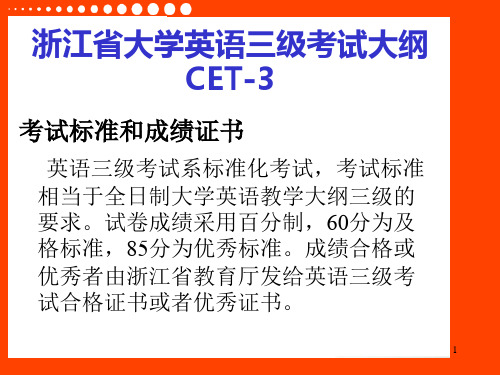
17
语法结构表格 VII
17. 主语、表语和宾语从句
17.1 三种从句
17.2 连接手段
17.3 It在主语从句和宾语从句中的应用
18. 定语从句 18.1 限制性定从和非限制性定从 18.2连接手段
18.3 the same / such … as 18.4 关系代词that的省略 18.5 特殊定从: which/as 指代句子 18.6 定从的分割现象
7
第四部分(Part IV reading comprehension) 阅读理解部分主要测试以下能力:
1. 掌握所给材料的中心大意。 2. 了解说明中心大意的事实和细节。
3. 既能理解字面意思,也能根据所给材料 进行一定的推断和判断。
4. 既能理解个别句子的意义,也能理解上 下文的逻辑关系。
阅读理解部分主要测试通过阅读获取信息 的能力,既要求准确,也要求有一定的 速度。
3.注意在阅读中培养语感,因为在语篇层次 上
培养的语感往往可以直接帮助答题
4.研究以往考试试题,适当多做些练习记住
典型题例
24
IV 61-75 阅读理解 15 30分 30分钟
V 76-80 英译汉 5 15分 20分钟
VI 81-85 汉译英 5 15分 20分钟
合计
85 100分 120分钟
10
题型
I. Listening 听力(共20题 @=1,共20分) Section A Question1-10 Section B Question 11-20(3 passages) II.Vocabulary 21-40 (共20题@=0.5,共10分) III. Structure 41-60 (共20题@=0.5,共10分) IV. Reading 61-75 (3 passages @=2, 共30分) V. Translation 76-80 (English—Chinese 5 sentences, @=3,共15分 ) 81-85 (Chinese—English 5 sentences,@=3,共15分 )
大学英语3电子PPT演示课件
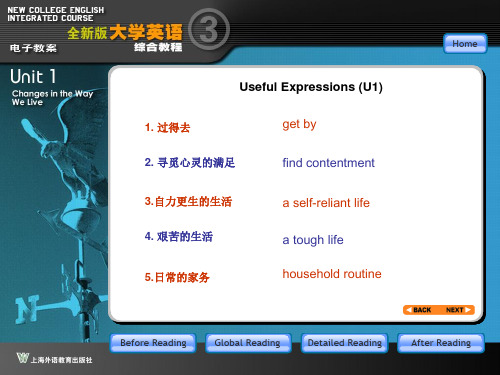
17. 生活水准/水平
standard of living / living standard
18. 弥补收入差额
make up the difference in income
19. 听歌剧看芭蕾演出
attend the opera and ballet
20. 耐得住寂寞
Useful Expressions (U1)
1. 过得去 2. 寻觅心灵的满足
get by find contentment
3.自力更生的生活 4. 艰苦的生活 5.日常的家务
a self-reliant life a tough life household routine
Home
Before Reading
10. 带着……的祝福
with sb.’s blessings
Before Reading
Global Reading
Detailed Reading
After Reading
Useful Expressions
11. 总的来说 12. 担任全职工作
on balance be employed full time
Global Reading
Detailed Reading
After Reading
Home
Useful Expressions
6. 正如老话说的那样 7. 温馨快乐每一分钟 8. 过冬 9. 常青藤联合会学校
as the old saying goes Love / enjoy every minute of sth. get through the winter Ivy League schools
大学英语三级B级-阅读理解(十五)
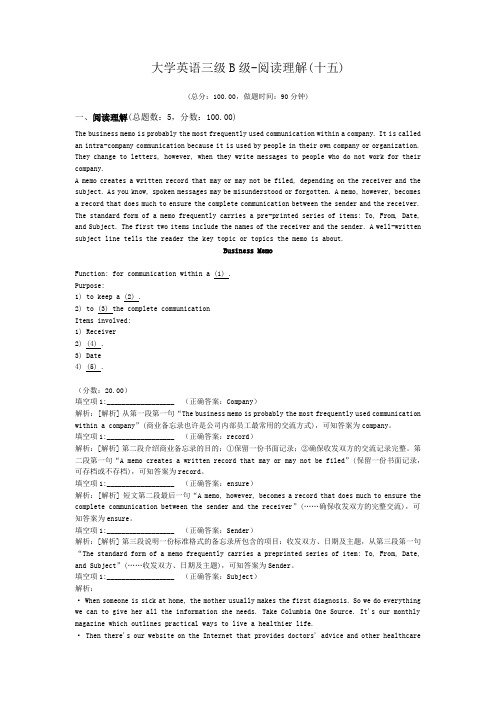
大学英语三级B级-阅读理解(十五)(总分:100.00,做题时间:90分钟)一、阅读理解(总题数:5,分数:100.00)The business memo is probably the most frequently used communication within a company. It is called an intra-company communication because it is used by people in their own company or organization. They change to letters, however, when they write messages to people who do not work for their company.A memo creates a written record that may or may not be filed, depending on the receiver and the subject. As you know, spoken messages may be misunderstood or forgotten. A memo, however, becomes a record that does much to ensure the complete communication between the sender and the receiver. The standard form of a memo frequently carries a pre-printed series of items: To, From, Date, and Subject. The first two items include the names of the receiver and the sender. A well-written subject line tells the reader the key topic or topics the memo is about.Business MemoFunction: for communication within a (1) .Purpose:1) to keep a (2) .2) to (3) the complete communicationItems involved:1) Receiver2) (4) .3) Date4) (5) .(分数:20.00)填空项1:__________________ (正确答案:Company)解析:[解析] 从第一段第一句“The business memo is probably the most frequently used communication within a company”(商业备忘录也许是公司内部员工最常用的交流方式),可知答案为company。
现代大学英语精读三Unit-1-PPT课件
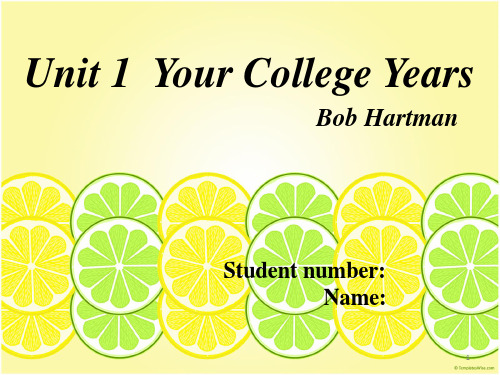
4. 平行结构 在英语中,并列连词and, but, as well as, both…and, neither…nor, either…or, not only…but also, rather than, as…as 等可连接两个对等的词或对等的结构,我们称之为 平行结构(parallel structure) 。平行结构的要求主要有以下 几个方面。
• what do you think about these differences?
4
While-reading
• New words • Phrases & Grammar • Structure • Style
5
New Words
1. Endeavor v. to try very hard eg. He endeavored to claim himself down but in
pro
ject
forward throw
向前投掷,向前扔,即规
划,计划
向前 投掷,扔
8
6. Option n. a choice you can make in a particular situation
辨析: Option 指特别赋予的进行选择的权利,强调的是进行选择的 自由和权利。 Choice 指运用自己的判断进行选择的机会,权利或能力,强 调的是进行选择的可能性。 Alternative 主要指在相互排斥的两者之间做严格的选择,也 可指在两者以上中进行选择。
A. 所连接的谓语形式必须一致。 eg. He went downtown, brought some books and visited his daughter. (went, bought 和visited 都是用的过去时)
全国英语等级考试三级阅读试题(8)
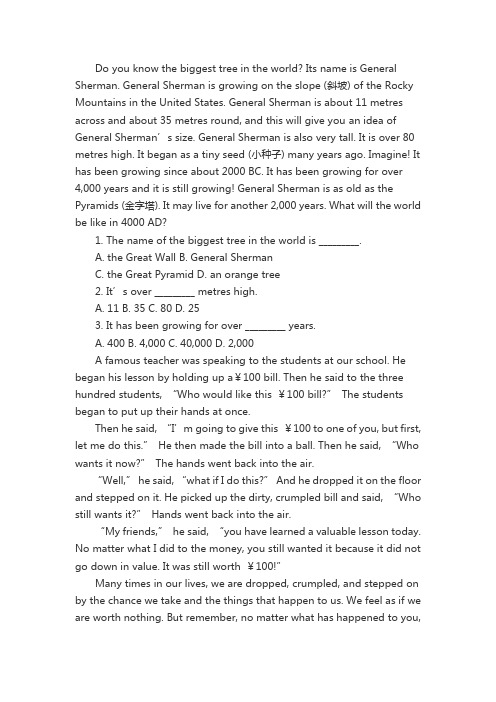
Do you know the biggest tree in the world? Its name is General Sherman. General Sherman is growing on the slope (斜坡) of the Rocky Mountains in the United States. General Sherman is about 11 metres across and about 35 metres round, and this will give you an idea of General Sherman’s size. General Sherman is also very tall. It is over 80 metres high. It began as a tiny seed (小种子) many years ago. Imagine! It has been growing since about 2000 BC. It has been growing for over 4,000 years and it is still growing! General Sherman is as old as the Pyramids (金字塔). It may live for another 2,000 years. What will the world be like in 4000 AD?1. The name of the biggest tree in the world is _________.A. the Great WallB. General ShermanC. the Great PyramidD. an orange tree2. It’s over _________ metres high.A. 11B. 35C. 80D. 253. It has been growing for over _________ years.A. 400B. 4,000C. 40,000D. 2,000A famous teacher was speaking to the students at our school. He began his lesson by holding up a¥100 bill. Then he said to the three hundred students, “Who would like this ¥100 bill?”The students began to put up their hands at once.Then he said, “I’m going to give this ¥100 to one of you, but first, let me do this.”He then made the bill into a ball. Then he said, “Who wants it now?”The hands went back into the air.“Well,”he said, “what if I do this?”And he dropped it on the floor and stepped on it. He picked up the dirty, crumpled bill and said, “Who still wants it?”Hands went back into the air.“My friends,”he said, “you have learned a valuable lesson today. No matter what I did to the money, you still wanted it because it did not go down in value. It was still worth ¥100!”Many times in our lives, we are dropped, crumpled, and stepped on by the chance we take and the things that happen to us. We feel as if we are worth nothing. But remember, no matter what has happened to you,you will never lose your value: you are always valuable to choose people who love you. Your value doesn’t come from what you do or whom you know, but WHO YOU ARE.You are special and valuable. Don’t forget it.4. Even though it was dirty, the money _________.A. still went up in valueB. was worth nothingC. didn’t go down in valueD. was still ours5. We are always valuable to the people _________.A. who pay usB. who call usC. who hate usD. who love us6. Your value doesn’t come from what you do but ______.A. who you knowB. who made youC. who you rememberD. who you are7. The sentence “Hands went back into the air.”means _________.A. the students put up their hands againB. the students put down their handsC. the students put their hands behind their backs againD. the students put their hands in front of themAkuapem is in the eastern part of Ghana. The sun there shines all the time. The local people are very friendly and hospitable(好客的).Now let’s have a look at how Akuapem people receive a visitor.A visitor is often welcomed warmly in a family of Akuapem. After the visitor is welcomed into the house, he is offered a seat and water at the very beginning, because the host assumes that the visitor must have come from a very long journey and need water. If there is a group of visitors, the host will greet the visitors from right to left. And the host shakes only with his right hand, because Akuapem people think the left hand is not clean.Next, the visitor is asked how his journey was and why he has come. While the conversation is going on, the wife and the children, especially girls, are preparing food for the visitor. The visitor can choose his favorite food. After the visitor finishes eating, the host and the visitor go on withtheir conversation. Usually this is a short one because the visitor is getting ready to say goodbye.When the visitor is leaving, he is often given some food. He is also accompanied(陪伴) by one of the children to the nearest station. The child who accompanies the visitor will not come back home until the visitor leaves safely.Whether he is a close friend or just a stranger, this is always how friendly Akuapem people receive a visitor.8. The underlined word “assumes”here probably means“_________”.A. thinksB. remembersC. disagreesD. follows9. Which of the following is TRUE according to the passage?A. The host talks little with the visitor.B. The child accompanies the visitor to the gate of the house.C. The host offers the visitor a seat only.D. The visitor takes some food with him when he leaves.10. From the passage we know that Akuapem people are _________.A. noisyB. friendlyC. impoliteD. quiet参考答案:1. B 由文中第一、二句Do you know the biggest tree in the world? Its name is General Sherman.可知答案。
三级上册英语期末复习课件阅读理解 牛津上海版(共8张PPT)
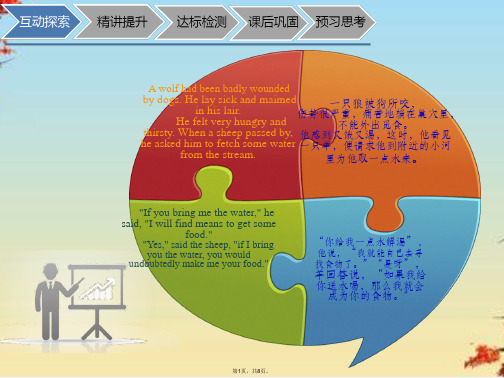
第3页,共8页。
A wolf had been badly wounded
A wolf had been badly wounded
I can fly, I can sing, too.
"If you bring me the water," he said, "I will find means to get some food.
第4页,共8页。
1. 摒弃不良阅读习惯
2. 扩大词汇量 3. 带着问题阅读 4. 遇到生词要会猜
5. 推论出文中隐含意思
第5页,共8页。
1.复习本节课学过的内容 2. 在30分钟之内完成讲义中的课后
练习
第6页,共8页。
第7页,共8页。
第8页,共8页。
"Yes," said the sheep, "if I bring you the water, you would undoubtedly make me your food.
People are happy to see me . Little bird can sing and dance.
知识梳理 I can fly, I can sing, too.
When a sheep passed by, he asked him to fetch some water from the stream.
伤势很严重,痛苦地躺在巢穴里,不能外出觅食。 ”“是呀”,羊回答说,“如果我给你送水喝,那么我就会成为你的食物。 A wolf had been badly wounded 他感到又饿又渴,这时,他看见一只羊,便请求他到附近的小河里为他取一点水来。
大学英语三级A试题题型.ppt
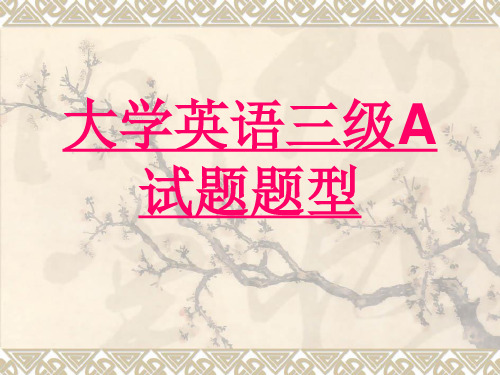
❖ 当实在无法选出时,排出错误选项之后选最 长的那个,可能性最大为B,C
Part 4 Traslation
❖ 英译汉 ❖ 汉译英
Part 4 Traslation
❖ 技巧: ❖ 英译汉:找答题点,关键词的翻译 ❖ 汉译英:基本功,单词的意思,翻译句子
的连贯性,句子成分的掌握
Part 5 Composition
大学英语三级A 试题题型
Part 1 Listening
★发下来试卷的时候立即看试题,快速浏览, 不是精读
★注意when,why,what,attitude,number及问 主旨等问题
★注意题目中的关键词,例如,the woman 而不是the man
★静下心来,听不到的果断放弃,继续下一 题
训练方法
❖ 基本是写信 ★写信的时候注意格式 ❖ 议论文 ★○议论文开门见山,观点鲜明
○三段式 ○开头结尾是亮点,多种句式,特殊用法
○字数,中间的写作尽量用熟悉的词的用 法,避免错误
Part 5 Composition
❖ 技巧: ★背范文 ★确定自己的写作模式,考场的时候只改单词,
基本框架不变 ★多写,开发框外思维 ★避免非智力因素扣分,卷面整洁度,单词拼
Reading Comprehension 五篇 (可能会有简单的常见词的习惯用法) (一些填空题)
Part 3 Reading Comprehension
❖ 做题技巧:平时练习控制时间
❖
找答题点(特殊的时间,大写词)
❖ 不要求句句理解,但是一定要找到正确答案
❖ 一般不确定的时候,不选特别绝对的选项, 如:一定能,一定不能,所有的人
○每天听一套试题的听力 ○第一遍听题目答案,第二遍对答案,可以边
- 1、下载文档前请自行甄别文档内容的完整性,平台不提供额外的编辑、内容补充、找答案等附加服务。
- 2、"仅部分预览"的文档,不可在线预览部分如存在完整性等问题,可反馈申请退款(可完整预览的文档不适用该条件!)。
- 3、如文档侵犯您的权益,请联系客服反馈,我们会尽快为您处理(人工客服工作时间:9:00-18:30)。
.
14
解题技巧:对比排除法
1. 抓住句子主干,结合原文,按照意群逐一 对比并排除含明显错误的选项;
2. 细致分析,找出翻译错误:
➢ 误译:语法含义和词汇含义 ➢ 漏译:根据语境和英汉表达习惯差异区分 ➢ 多译:随意增加原文没有的语句
.
15
真题分析
• T1. It is because thseey see acknowledging the existence ofaosthaewrsayas a way of avoiding being rude.
4)Which of the following is closest in
meaning to the underlined word in the
second paragraph?
.
10
透过现象看本质,领悟作者思想倾向、
观点、立场、语气选及项中态与度原等文说。法完
推
全相同的一般不能选
理 判
以原文内容为前提,据作者的观点理 论(非自己观点),客观地对文中未明显说 明的现象或事例给予合理的逻辑推断,
3. Which of the following can be inferred
(推论)?
4. What is the tone (语气) of the author?
5. What is the purpose (目的) of this
passage?
6. The passage is intended to _____.
.
5
主旨大意题答题技巧
1.认真阅读文章的第一段或每段的
第一个句子, 中间部分则可采用略读
或扫读的方式
2.文章的主题作者往往有意识地反复论
述。抓住反复出现的中心词,即
高频词,也叫主做旨主题的题答词案往。往
是两个极端,或是范
围太大,或是太小。
.
6
文章中心是论点,事实细节是论
据或主要理由;有关细节的问题常对
A.因为他们意识到其他人的存在,所以自己不能粗鲁。
B. 因为他们看见其他人的出现,因此自己不能粗俗。
C. 这是因为他们看到承认其他人的存在就避免了粗俗。
Reading Comprehension
Crystal
.
1
英语三级考试大纲
题型
具体内容
时间 分值
听力
15题:10个对话+2篇 20分钟
短文+1篇填词
语法结构与 20题, 60%语法结构, 15分钟
词汇
40%词汇
阅读理解 20题,四篇短文, 40分钟
70%细节题; 30%其
他。
英译汉 5题,4选自阅读理解 15分钟
断 做出一定解释。 答案讲的太具体 型 也不能选
推理判断题:着重考查学生归纳概括、
逻辑推理等综合能力。
.
11
命题方式:
1. The passage implies (暗示)that_______.
2. We can conclude (得出结论) from the
passage that_____.
.
8
释义法 对文章中的生词用定语(从句)、
表语甚至于用逗号、破折号等标点符号引出
词 并加以解释说明。
义 逻辑法 根据内在逻辑关系推测词义,如
猜
并列and或or,对比转折but, however, in spite of或on the contrary,因果so和beca或者根据复合词的各
事
文中某个词语、某句子、某段落等细 节及事实进行提问,所提问题一般可
实 直接或间接在文章中找到答案。
细
解题原则:忠实于原文上下文
节
及全篇的逻辑关系,决不能主观臆断。
型
提问的特殊疑问词常有:what,
who, when, where, why, how等。
.
7
命题方式: 切忌匆忙答题,排除
法,choose the best one 1)Which of the following statements is
true?
2)Which of the following is not mentioned in the text?
3)The author ( or the passage) states/indicates that___.
4)According to the passage, when ( where, why, how, who, what, which, etc.)___?
部分猜测词义。
.
9
命题方式:
1)The underlined word(phrase)in the passage can be replaced by ____.
2)The word "it(them)"in the first paragraph refers to ____.
3)The underlined sentence in the last paragraph means ____.
1)What does the writer mainly tell us? 2)Which of the following can summarize the main idea of this text? 3)Which of the following best expresses/ state the general idea? 4)Which is the subject/ topic discussed in the text? 6)What’s the best title for this passage?
7. Where would this passage most
probably appear? .
12
Translations
Crystal
.
13
英译汉
• 本部分共5题,其中4题分别选自第三 部分阅读理解的四篇文章,每篇选1至 2句组成一题,每题20词左右,4题的 总词量不超过80个。
• 本部分的主旨为考核考生根据上下文 确切理解英语书面材料的阅读能力及 将其通顺地译成汉语的书面表达能力。
写作
100个左右英语命题 30分钟
作文 .
15分 20分 40分
10分 15分
2
解题步骤
读题:找关键字词
带着K关e键y字e词x:pr找e读s文si章ons
找读文章&:联系上下文
context
联系上下文:读选项
读选项:选择最佳答案
.
3
命题类
1
主旨大意型
2
事实细节型
3
词义猜测型
4
推理判断型
.
4
命题方式:
